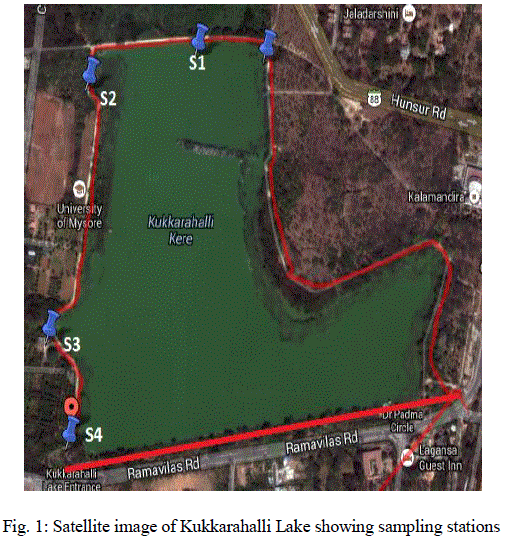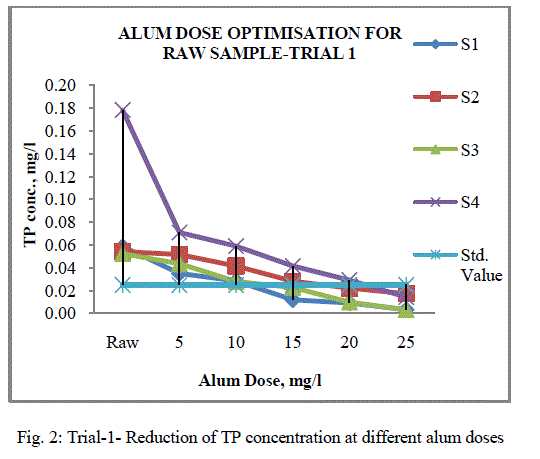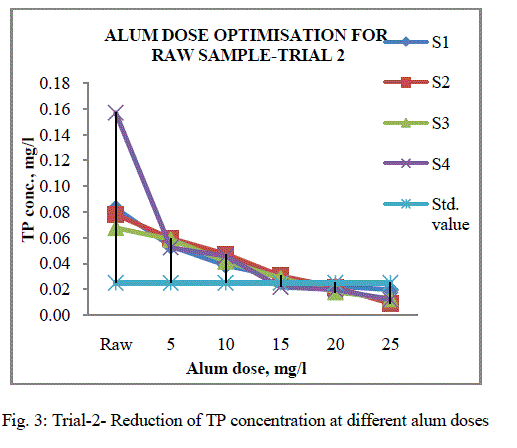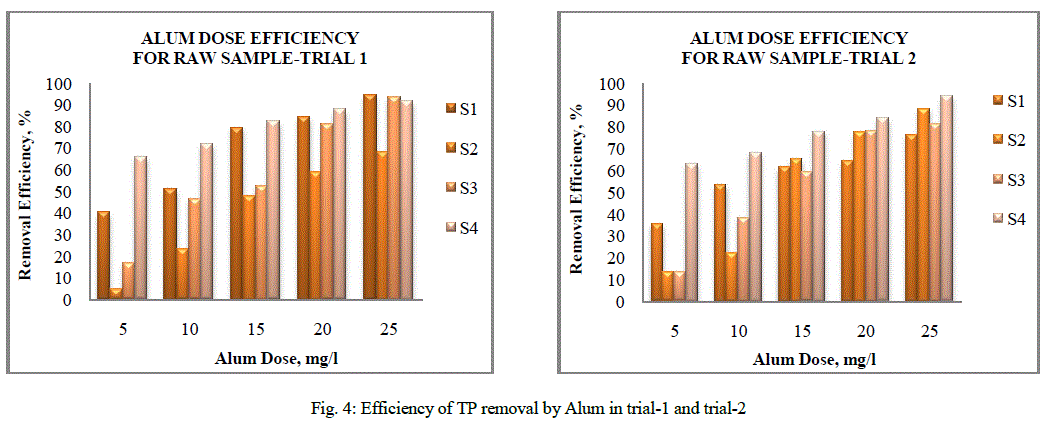ISSN ONLINE(2319-8753)PRINT(2347-6710)
ISSN ONLINE(2319-8753)PRINT(2347-6710)
Roopa .C1 and Sadashiva Murthy .B .M2
|
| Related article at Pubmed, Scholar Google |
Visit for more related articles at International Journal of Innovative Research in Science, Engineering and Technology
In-line Alum injection facility is an innovative application technology in restoring lakes. In this technology, guidelines for dose calculation and application are lacking. In this study, Jar tests are carried out to optimize alum dose and study alum effect on pH. Four major inlets to lake are taken for study of water quality and application of alum treatment. This treatment resulted in immediate and substantial improvements to water quality in Kukkarahalli Lake. Tests showed that alum dose between 15-20 mg/L is sufficient to decrease phosphorus from around 0.1 mg/L to below 0.025 mg/L which is the limiting value for eutrophication. Alum doses of up to 20 mg/L did not depress pH below the recommended minimum pH of 6. Test study were conducted to see the effect of pH on alum treatment, it is seen that at a pH of 6, alum dose application can be reduced to between 5-10 mg/L.
Keywords |
| Alum, Lake in-let treatment, Eutrophication, Total phosphorus, Jar test |
INTRODUCTION |
| Lakes in urban region are ecologically sensitive zones and true indicators of sustainable and progressive urban development. Generally, the wastewater discharged to lakes contains excess levels of nutrients such as nitrogen, phosphorous and organic substances. These are an important macro-nutrient for plant and microorganisms growth resulting in excessive growth of algae and aquatic weeds in lakes resulting in serious impairment to water quality leading to eutrophication. Thus, it is necessary to reduce the concentration of external phosphorus, nitrogen from inflowing wastewater to prevent the algal bloom. To achieve this innovative method of reducing external phosphorus loading to lakes uses engineered systems to treat lake inflows with aluminum sulfate (Alum) [4]. The addition of alum to inflowing wastewater results in the production of chemical precipitates which remove pollutants by two primary mechanisms. Removal of suspended solids, algae, phosphorus, heavy metals, and bacteria occurs primarily by enmeshment and adsorption onto aluminum hydroxide precipitate. Removal of additional dissolved phosphorus occurs as a result of direct formation of aluminum phosphate. The aluminum hydroxide precipitate is a gelatinous floc which attracts and adsorbs colloidal particles onto the growing floc, thus clarifying the water. Chemically, phosphate is most commonly removed by precipitation. Precipitation processes are capable of at least 90-95% phosphorus removal at a reasonable cost [2]. Alum treatment is popular because of its simplicity and the fact that it produces immediate reductions in phosphorus concentration [6]. Although Alum appears to be easy to apply, the phosphorus removal action only occurs when it forms a floc. The successfulness of Alum is affected by several physic-chemical and environmental factors such as pH, alkalinity, coagulant dose, speed of flash mixing and other interfering substances [2]. A recent comprehensive study of phosphorus removal by alum showed that maximum removal of phosphorus is achieved at pH of 5–6 and temperature has little effect on alum efficiency. |
| Kukkarahalli Lake is taken as the study area where due to severe inflow of wastewater by sewage, lake is in a state of high eutrophication. The objective of this study is to determine in-line alum application to inflowing wastewater by determine the optimum alum dose and effect of alum on pH .And then to optimize Alum dose and pH for inflowing lake wastewater application. A series of jar tests were conducted to achieve the objectives. |
RELATED WORK |
| A series of jar tests were used to examine the optimal alum dose to remove Phosphorus (P) at inlet of Jameson Lake. Jar tests were done keeping natural turbulence as mixing regime conditions. Studies showed that slow intensity flash mixing did not enhance P removal efficiency. Tests resulted an alum dose of 5 mg-Al/L was sufficient to decrease P from around 0.13 mg-P/L to below 0.02 mg /L [4]. In this study [9], mechanisms involved in phosphorus removal from eutrophic lake water with aluminum were assessed by laboratory investigation using jar tests. The maximal TP removal efficiency (90–95%) was obtained for an Al concentration ranging from 2 to 5 mg /L. Authors [2] conducted a study on low alkalinity wastewater (50 mg/L) to evaluate the optimum pH, dosage and performance parameters for the common coagulant alum series of jar test was conducted in this study using low alkalinity wastewater to evaluate the optimum pH, dosage and performance parameters. From the experiment, it was found that the dosage of coagulant and removal of phosphorus depend upon the pH .The final optimum pH for efficient P removal was found to be within the range of 5.7-5.9. It was also seen that at pH 7 effluents with the total phosphorus content of 0.3 mg /L was obtained. Studies by authors [6] were conducted to determine dose of Alum for lake in restoration process. Titration of lake water samples of varying alkalinity allowed establishing relationship between residual dissolved aluminium, alkalinity and dose which can then be employed. Authors [7] studied about factors that affect phosphorus adsorption .Aluminium salts are used for combating internal P loading .They used an Aluminium concentration similar to that of a whole lake restoration experiment where a 4:1 molar ratio between Al and the mobile P pool in water and surface sediment was targeted. The reduction in P removal effectiveness observed in our study can in all cases possibly be overcome by increasing the amount of aluminium added in a treatment and since the interactions in natural lake water appeared very complex. |
SCOPE OF RESEARCH |
| In the present study, Kukkarahalli Lake in Mysore city is taken as study area. Rapid urbanisation has contributed to large amount of wastewater inflow into lake resulting in eutrophication of lake. Increasing amount of algal growth can be controlled by limiting nutrients which consist of phosphorus and nitrate inflow into lake is one of the ways to reduce lake eutrophication. This can be achieved by treating inflow wastewater. Alum is used in present research study to treat nutrients from inflowing wastewater and allow low clear water which has less phosphorus concentration which helps in restoring lake. |
| In-line Alum injection facility is used to achieve reduction of phosphorus concentration. Alum dose determination to treat inflow wastewater is the main objective of the study. To achieve this series of jar tests are conducted to optimise the dose to limit phosphorus inflow into lake. Study of alum effect on pH is also conducted to find effective pH at which treatment process can be applied. |
MATERIALS AND METHODS |
Site Description |
| Kukkarahalli lake is one of the manmade lakes in Mysore city, having catchment area of more than 414 square kilometres and the water body spreads over 62 hectares (150 acres).It was constructed during the rule of Maharajas of Mysore to fulfil the needs of water for various purposes. This lake not only met the domestic and irrigation water needs of people, but also enhanced ground water table of area and aesthetics of city. Thus, lake positively influenced the sustainable and progressive development of Mysore city. Due to severe contamination by sewage into lake is in a state of high eutrophication. The spread is covered with weeds like water hyacinth, reeds and algal blooms. Sewage, garbage and silt inflow into the lake has affected its water quality and eutrophic state. There are 6 major inlets that have been identified around the upstream, contributory drains to the lake, which mainly carry wastewater and natural runoff from surrounding areas into lake. |
Sampling |
| 6 inlets around the lake were indentified which feed wastewater into lake. Among these inlets which contributed to major source of feed were identified and selected for the study. 4 major inlets which contributed maximum flow and which were main source of pollution are selected for the study. Water samples were collected from four major inlets of Kukkarahalli Lake as show in satellite image (Fig.1). Sampling stations S1, S2, S3 and S4 all consisted of sewage and runoff water from surrounding areas of lake. Sample from the inlet (5 L) were collected in plastic cans by grab sampling method. Samples were stored on ice in ice chests until returned to the lab, and then were stored in a walk-in refrigerator at 4°C until analysed. |
 |
Laboratory analysis |
| Jar tests were conducted for the collected samples using 1.0 L samples, on a six stirrer Jar test apparatus. Jar test procedure adopted was as follows: The appropriate amount of alum stock was added to each sample, and flash mixed at 220 rpm for 1.25 minutes, then followed by flocculation at 25 rpm for 30 minutes. The samples were then allowed to settle for 1 hour until all of the floc had fully settled. After the settling period, samples were taken and analyzed immediately. Before and after treatment samples were measured for pH, Total phosphorus (TP), Total nitrogen (TN), BOD and COD. The objective of the testing was to identify the optimum dose of Alum and pH for its application to remove TP. To find the optimum alum dose required to remove external phosphorus inflow into lake, jar tests were performed at doses of 5, 10, 15, 20 and 25mg/L Alum. Based upon the pH variation results of the initial testing, optimization of pH for alum application was carried out. The pH was adjusted to the desirable level with the addition of 0.1 N HCl. The required pH of 6 was obtained. Then tests were performed at same doses of 5, 10, 15, 20 and 25mg/L Alum. |
| The pH of the samples was measured with at Elico pH meter; Total phosphorus and Total nitrogen were measured using Varian Spectrometer. |
RESULTS AND DISCUSSIONS |
| The results of this study showed that inflowing wastewater treated with alum may be an effective way to remove TP concentration from Kukkarahalli Lake water. The removal of TP will reduce the potential for future water quality problems in the lake. To determine Alum dose, a standard limiting value of 0.025 mg/L of TP was taken as reference value. Two trails were conducted to optimise dose of alum that has to be use in in-line injection process. Wastewater samples collected from 4 inlets S1, S2, S3 and S4 were used for jar test studies. |
| In first trial of experiment, it was observed that, for sampling stations S1 and S2, which had almost same initial concentration of phosphorus consumed Alum dose of 15 and 20 mg/L. At S3 sampling station which had more turbidity and S4 which had the maximum phosphorus concentration at inlet used an Alum dose of above 20 mg/L was sufficient to drop TP concentration to less than 0.025 mg/L. From the graph patterns obtained in first trail of jar test, it is evidential that with increasing alum dose the removal of TP also improves (Fig. 2) |
 |
| From the jar test results the efficiency of application of Alum at inlets of lake were studied by plotting graph patterns. For both the trails efficiency were calculated separately to determine the optimum dose. An average TP removal efficiency above 50% was obtained in both trial cases (Fig.4). At alum dose above 15mg/L it was found removal efficiency was more than 80% which resulted in clear water with all particles settling at bottom. At alum dose of 5 mg/L the efficiency of removal in S2 station in found to be least, other stations also showed less removal efficiency at 5 and 10 mg/L. |
 |
| essential to arrest the algal growth. By neutralising pH to 6, initial TP concentration at S2 and S3 stations which were almost same was effectively removed below detection limit. As S4 which had max TP concentration too showed removal at 5 mg/L. This is achieved mainly by neutralising pH which increases the adsorption of phosphorus molecules on Alum forming flocs easily. From the obtained results removal efficiency graphs were studied. It is also observed that a removal efficiency of 80% is obtained at lower alum dosage value of 5mg/L (Fig. 6). From results neutralising pH is much more effective than the previous studies which were conducted using raw water collected from lake inlets. TN concentration in the experiment showed reduction in very low percentages and pH did not have any influence on the removal from water sample. |
 |
CONCLUSION |
| In-line alum treatment for Lake Inlet water is substantially less expensive, longstanding and effective whole-lake management strategy to control external phosphorus loading. This method often requires no additional land purchase. While the results of these laboratory studies are promising. However, treating inflows with alum has a number of challenges not generally associated with lakes treatment, the continuous and/or seasonal nature of inflow treatment and solids management. Further studies have to be done to find the acute toxicity criteria of alum dose that has to be limited for the protection of aquatic life in lakes. |
ACKNOWLEDGEMENT |
| The authors are thankful to the Department of Environmental Engineering, Sri Jayachamarajendra College of Engineering for permitting and providing necessary facility to carryout present research work. We also thank Kukkarahalli Lake Staff for providing permission to collect samples and sincerely appreciate their kind help. |
References |
|